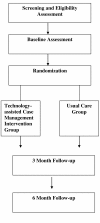Effectiveness of technology-assisted case management in low income adults with type 2 diabetes (TACM-DM): study protocol for a randomized controlled trial
- PMID: 22014122
- PMCID: PMC3219699
- DOI: 10.1186/1745-6215-12-231
Effectiveness of technology-assisted case management in low income adults with type 2 diabetes (TACM-DM): study protocol for a randomized controlled trial
Abstract
Background: An estimated 1 in 3 American adults will have diabetes by the year 2050. Nationally, South Carolina ranks 10th in cases of diagnosed diabetes compared to other states. In adults, type 2 diabetes (T2DM) accounts for approximately 90-95% of all diagnosed cases of diabetes. Clinically, provider and health system factors account for < 10% of the variance in major diabetes outcomes including hemoglobin A1c (HbA1c), lipid control, and resource use. Use of telemonitoring systems offer new opportunities to support patients with T2DM while waiting to be seen by their health care providers at actual office visits. A variety of interventions testing the efficacy of telemedicine interventions have been conducted, but the outcomes have yielded equivocal results, emphasizing the shortage of controlled, randomized trials in this area. This study provides a unique opportunity to address this gap in the literature by optimizing two strategies that have been shown to improve glycemic control, while simultaneously implementing clinical outcomes measures, using a sufficient sample size, and offering health care delivery to rural, underserved and low income communities with T2DM who are seen at Federally Qualified Health Centers (FQHCs) in coastal South Carolina.
Methods: We describe a four-year prospective, randomized clinical trial, which will test the effectiveness of technology-assisted case management in low income rural adults with T2DM. Two-hundred (200) male and female participants, 18 years of age or older and with an HbA1c ≥ 8%, will be randomized into one of two groups: (1) an intervention arm employing the innovative FORA system coupled with nurse case management or (2) a usual care group. Participants will be followed for 6-months to ascertain the effect of the interventions on glycemic control. Our primary hypothesis is that among indigent, rural adult patients with T2DM treated in FQHC's, participants randomized to the technology-assisted case management intervention will have significantly greater reduction in HbA1c at 6 months of follow-up compared to usual care.
Discussion: Results from this study will provide important insight into the effectiveness of technology-assisted case management intervention (TACM) for optimizing diabetes care in indigent, rural adult patients with T2DM treated in FQHC's.
Trial registration: National Institutes of Health Clinical Trials Registry (http://ClinicalTrials.gov identifier# NCT01373489.
Figures
References
-
- Centers for Disease Control and Prevention. Press Release: older, more diverse population and longer lifespans contribute to increase. Atlanta, GA: U.S. Department of Health and Human Services, Centers for Disease Control and Prevention; 2010. Accessible from: http://www.cdc.gov/media/pressrel/2010/r101022.html.
-
- Centers for Disease Control and Prevention. National diabetes fact sheet: general information and national estimates on diabetes in the United States, 2007. Atlanta, GA: U.S. Department of Health and Human Services, Centers for Disease Control and Prevention; 2008.
-
- SC DHEC; South Carolina Diabetes Prevention and Control Program and Diabetes Initiative of South Carolina; Medical University of South Carolina; Diabetes Center. Burden of diabetes in South Carolina, 2009 Edition [Report] Columbia, SC: Department of Health and Environmental Control; 2009. Accessible from: http://www.scdhec.gov/administration/library/CR-009477.pdf.
-
- National Institute of Diabetes and Digestive and Kidney Diseases. National Diabetes Statistics fact sheet: general information and national estimates on diabetes in the United States, 2005. Bethesda, MD: U.S. Department of Health and Human Services, National Institutes of Health; 2008.
Publication types
MeSH terms
Substances
Associated data
Grants and funding
LinkOut - more resources
Full Text Sources
Medical
Miscellaneous





